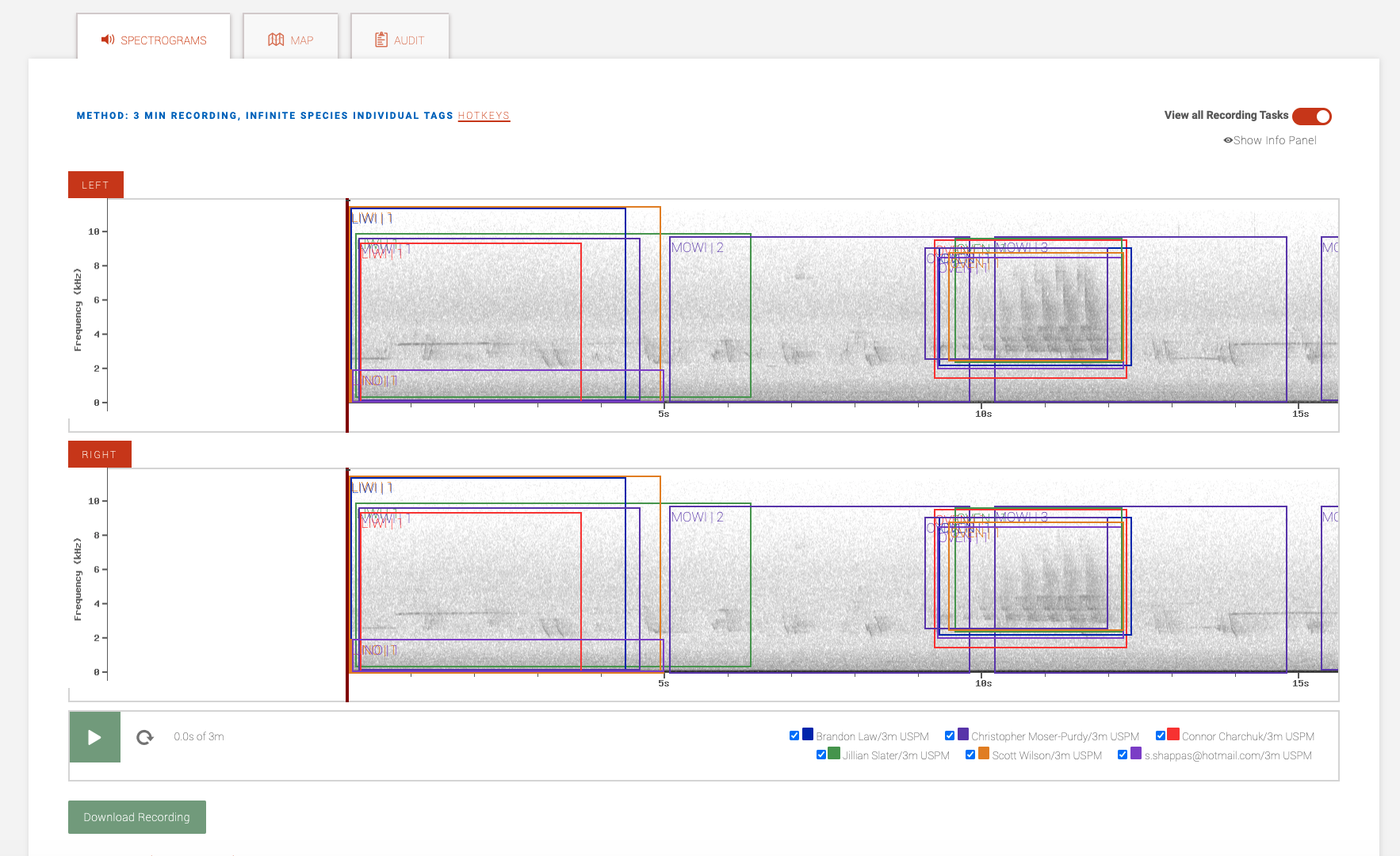Index
4.1 Audio data concepts
Acoustic recordings are made by sampling sound pressure waves from the environment. Sampling rate (the number of samples taken per second) and bit depth (degree of quantization of pressure measurements) are two important values to consider when making sound recordings. Waveforms or the shape of the total acoustic signal over time are difficult to interpret.
These waveforms can be transformed into spectrograms. This is done using algorithms called Fourier transformations to make acoustic data more intelligible to a human or other software. These spectrograms contain patterns that a human can more easily use to recognize an acoustic signal and convert this into biological data, such as, animal vocalizations.


Animals use acoustic signals to communicate messages for mate attraction, territorial defense, identification or alarm. Acoustic signals are important metrics that biologists and scientists can use to study animal populations, community assemblages or individual fitness. Collecting sound signals also provides a permanent, unbiased, analyzable and reproducible dataset for researchers in contrast to point count data.
Sampling design
An ARU can be deployed at a location for a long period of time. This provides a number of benefits to users processing acoustic data and project administrators to optimize their study design. If you're just getting started using ARUs, WildTrax's recommendations on how to best process acoustic data is based on the analyses, reports and publications which can be found in the Resources section.
- How long you leave an ARU out at a location and how much data you process depends on your objective. Thus, there is no one answer that optimizes results for all species or for all questions. Inclusion of amphibians, owls, nocturnal species etc. changes the best ways of visiting your locations with ARUs.
- For songbirds, there is strong evidence that shorter duration surveys (e.g. 1-minute) will increase detection rates and allow for greater number of recordings from different days to be processed. This will result in more species found faster. Trade-offs with other methodological approaches will occur however. For example, 1 minute methods have higher detection error per visit but cumulatively have higher detection overall if you put in equal effort (10 x 1-minute point counts vs. 1 x 10 minute point counts). More work is need in understanding the implications from using occupancy estimates from short versus longer periods of sampling time per individual point counts in terms of the stability of occupancy estimates.
- There are no firm recommendations on whether the total time should be 3, 5, or 10 minutes, etc. per recording processed. However, we do strongly recommend that listening in 1-minute time blocks within any longer interval provides the greatest flexibility in methods from an ARU and highest return on processing investment. The ability to estimate parameters such as song rate with USPM methods, increases the utility of such data and has the potential to help better measure a greater array of state variables (e.g. singing rate, occurrence or density).
- A single day of recording does not seem to be the best way to estimate occupancy or assess probability of occurrence. Leaving an ARU to record at a location for several days seems to provide a reasonable balance in getting detections from species that hold territories close to an ARU while also increasing the probability of getting rarer species with larger home ranges that only periodically are near an ARU. Less is gained by leaving them out for a month if it comes at the cost of visiting more locations
Tasks
In order to process data, a task must be generated and assigned in WildTrax. A task is a unique combination of an acoustic recording, a processing method and an observer. The observer needs to be at least a read-only project member and assigned the recording in order to process it. WildTrax has the ability to process acoustic recordings with multiple methods and users, however, please contact WildTrax Support to provide this service.

Recommended equipment
The following equipment is recommended for processing acoustic data. Proper equipment will enhance your experience and data quality using WildTrax.
- Computer with stable, high-speed internet connection and a minimum screen size of 15”
- Headphones with the following specifications:
- Stereo
- Circumaural (fully enclosing the ear)
- Minimum frequency response: 20 – 20000 Hz
- No bass boost (flat frequency response)
Contact WildTrax Info regarding headphone specifications if you are unsure if your headphones meet specifications.